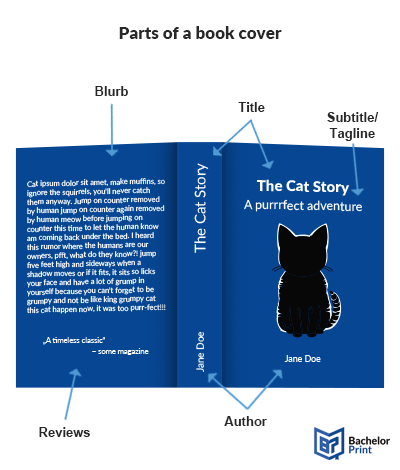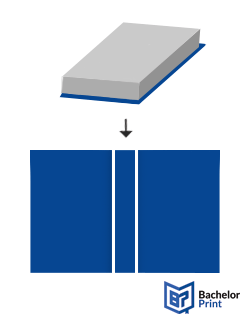
A book in bookbinding consists of several distinctive parts that make up the physical appearance of the printed work. While the book block consists of the actual story printed on paper, the cover envelops and protects the pages while adding an appealing visual appearance. This article will explain every detail about the book cover, its purpose, history, and design process.
Inhaltsverzeichnis
Definition: Book cover
The book cover is the protective covering around the text block, binding it together. It includes the front, back, and book spine in the traditional sense. In modern days, the term book cover also refers to the image on the front of the cover that is used as a title image on online platforms, libraries, or shops. The physical cover of a book is made from book board covered in book cloth or other materials or simply made from sturdier paper, as in a paperback binding.
Note: Often used as a synonym is the term “dust anorak,” which, however, refers to a paper envelope for the actual cover for extra protection.
Hardcover with individual embossing
- Price calculator & 3D live preview
- Professional binding for thesis, dissertation, or books
- Print on demand with fast delivery right to your doorstep
Learn more!
Purpose
A book cover, first and foremost, serves the purpose of protecting the book block it contains. It usually consists of sturdy materials, enabling it to withstand physical influences and weathering over time. However, book covers also serve other purposes as listed below:
Marketing
While you are not supposed to judge a book by its cover, real books are often evaluated by exactly that. The front image and the title are typically the main reasons why a book gets sold quickly.
Creativity
In many cases, the cover also provides the first impression of characters, setting, or the general atmosphere of the story, stimulating the creativity of the readers to continue imagining further.
Sneak peep
The blurb on the back or sometimes inside the cover reveals a summary of the story that teases the content and leaves the reader wanting more.
Information
A book cover also gives information about the author or reviews from previous test readers to give an impression of how the book is perceived by others.
Parts
Every book cover has to include certain parts of information to convey to the reader:
Blurb
The back of the book cover contains the blurb, a catchy summary of the content, to show the reader what they can expect from the book.
Title
Every book needs an original and unique title to distinguish it from other works as well as hook the reader at first glance.
Image
The design needs to be intriguing and eye-catching to invite the reader into the book or just gain their attention on the shop shelf. Also consider the back of the cover while designing, as the entire covering should fit together as one piece.

Subtitle
Sometimes, books also have a subtitle or tagline to further describe or clarify the title. This is optional, though.
Reviews
The back of the book can also contain reviews from well-known test readers or magazines.
Biography
On the inside of the cover, there is often a brief biography of the author, which provides background information. This is also optional.
Author
The cover also states the name of the author, whether it is the real one or a pseudonym.
Types
There are two types of book covers to be differentiated: the hardcover and the paperback. A hardcover is mainly associated with a real book cover, as it consists of sturdy frames enveloping the book block. A paperback, on the other hand, has a cover simply made from thicker paper, which makes it more affordable and easier to carry around. A more extensive comparison of these two can be found in the following article.
History
In the beginning of bookbinding, the cover was elaborately made by hand, binding the pages with cotton or bookbinding glue. As books were expensive due to the individual making process, they were also often adorned with gold, silver, and jewels to enhance their visuals.
In the 1820s, with the invention of the steam engine, bookbinding became cheaper and easier, making printed works affordable to many people. The book cover also changed in that full stop, as paper-covered fronts allowed for printed designs through lithography or halftone illustrations. These possibilities also shifted the focus of the cover from pure protection to marketing and advertising purposes.
Design
The process of designing a book cover is often underestimated by authors and publishers, as it takes a lot of attention to detail and structure. The following steps will present a guideline to follow.
-
-
Book cover size:
Before starting the actual design, setting the dimensions of the book and the cover is essential. The design is always scaled according to these dimensions and is thus the base for the creative process. -
Purpose:
Book covers can serve different purposes. Some are meant to be eye-catching to lean into impulsive buying behaviour, some want to convey luxury and importance, academic books need to look professional, while children’s books address both the kids and their parents. Defining the target audience is an important step, followed by the individual intention of the author. -
Design the image:
Whether you design the cover image yourself or hire a graphics designer, in this step, the main image is created. In this step, accounting for the genre of the book is necessary to match the expected vibe of the story. The image can show a landscape, words, characters, patterns, or whatever the author desires and deems fitting. -
Add text:
In the last step, you add the title, author name, blurb, and every other piece of text the cover might need. It is significant to give attention to the font style, letter sizes, and the overall composition. There might also be changes in the cover design if the text has not been considered earlier. -
Final check:
After the cover has been completed, most programmes or websites offer a preview feature to check the formatting and visuals before submitting the work. Especially when the cover includes the front, spine, and back as a single graphic, a review is highly necessary to ensure that the image is in the right place.
-
Book cover size:
Paperback with your individual design
- Individual design for thesis, dissertation, or books
- Order online with fast delivery right to your doorstep
- Use a customizable pre-made design or create your own
Learn more!
Step-by-step
Binding a hardcover by hand is not as difficult as it appears to be. The following guide will lead you along the individual steps.

At first, you need to select and cut a book board. This can be made from cardboard or other materials, which are listed in the corresponding article. This book board is cut in a size a little bigger than the text block, as it serves as a bumper against external influences. The margin should not be too wide to avoid bending, but it is eventually decided by the preference of the maker of the book. Necessary are two identical squares for the front and the back, and a smaller one for the spine. The spine should have the same height as the other two pieces and the width of the corresponding book block.
Next, you select a piece of book cloth or paper to envelop the cover. After one piece of the cover is secured, you can use a casemaking square or a simple ruler to measure 6-8 mm around it. If the book board is very thick or you are not yet familiar with bookbinding, you can also leave the margin wider. Between the cover and the spine piece, you should leave a margin of about 4 mm. Finalize this step by cutting the corners, as you can see in the picture.

The margin then gets folded over and is glued to the book board before the text block is attached to the spine and the covers with endpapers. If you want to attach a ribbon bookmark, stick it to the back of the book block before securing the block into the cover. Another variant would be sewing the pages into the spine, which often happens with leather covers.

FAQs
There are mainly two types of book covers: the hardcover and the paperback. A hardcover consists of a sturdy binding, while the softcover is made from thicker paper.
A good book cover needs an intriguing image, the title, the name of the author, a blurb or reviews on the bottom, and, in some cases, a subtitle or tagline.
A cover is important, as it catches the reader’s eye in a shot and thus serves marketing purposes, but it also gives information about the story and the author.
A hardcover is usually made of sheets of book block, book cloth, or paper, connected to the book block by glue or cotton binding.